business strategy企业战略管理英文版(上海财经大学 董静)
- 格式:ppt
- 大小:6.28 MB
- 文档页数:173
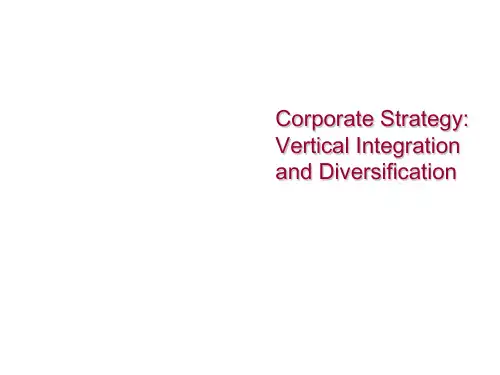

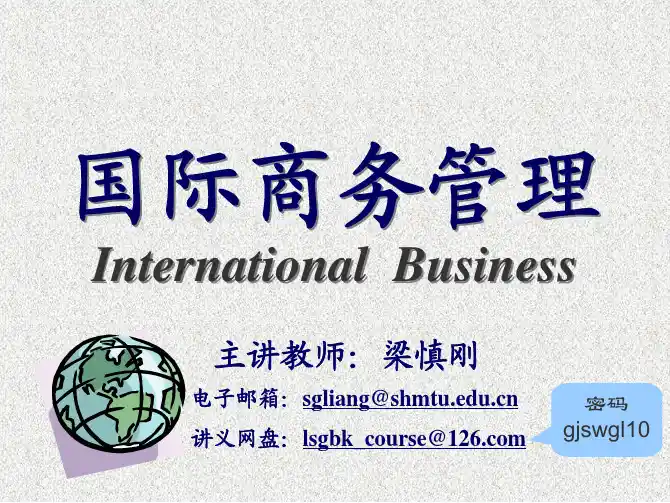
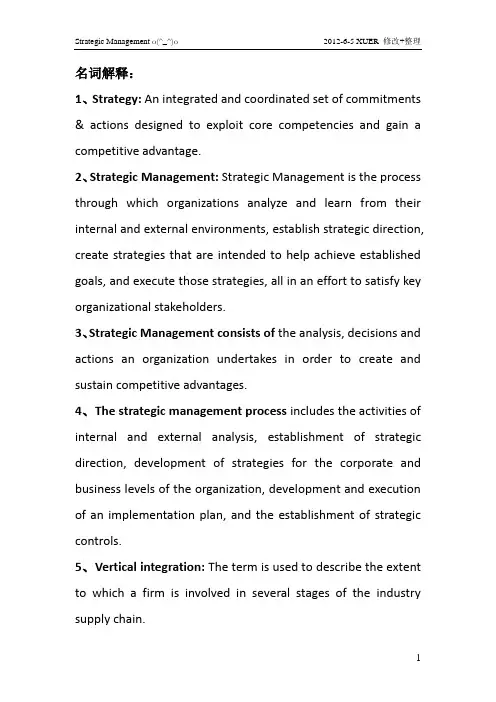
名词解释:1、Strategy: An integrated and coordinated set of commitments & actions designed to exploit core competencies and gain a competitive advantage.2、Strategic Management: Strategic Management is the process through which organizations analyze and learn from their internal and external environments, establish strategic direction, create strategies that are intended to help achieve established goals, and execute those strategies, all in an effort to satisfy key organizational stakeholders.3、Strategic Management consists of the analysis, decisions and actions an organization undertakes in order to create and sustain competitive advantages.4、The strategic management process includes the activities of internal and external analysis, establishment of strategic direction, development of strategies for the corporate and business levels of the organization, development and execution of an implementation plan, and the establishment of strategic controls.5、Vertical integration: The term is used to describe the extent to which a firm is involved in several stages of the industry supply chain.6、Horizontal integration: The process of acquiring or merging with industry competitors to achieve the competitive advantages that arise from a large size and scope of operations.7、Diversification strategy describes the scope of the firm in terms of the industries and markets in which it competes.8、Related diversification implies organizational involvement in activities that are somehow related to the dominant or “core” business of the organization, often through common markets or similar technologies.9、Unrelated diversification does not depend on any pattern of relatedness. Unrelated diversification has lower profitability and higher risks than those pursuing other corporate-level strategies such as concentration or related diversification.10、Organizational fit: When two organizations or business units are merged or acquisition happened, and the organizational management processes, cultures, system, and structures are matching(similar), this is organizational fit.11、Marketing strategy: Marketing strategy is the plan for investing marketing efforts and resources (advertising, branding, distribution, etc.)to achieve business goals.To support growth strategiesTo support a stability or retrenchment strategy12、Economies of scale: Economies of scale refers to the cost advantages that an enterprise obtains due to expansion. There are factors that cause a producer’s average cost per unit to fall as the scale of output is increased. "Economies of scale" is a long run concept and refers to reductions in unit cost as the size of a facility and the usage levels of other inputs increase.(1)Economies of scale. Unit cost reductions associated with a large scale of output •Larger production runs•Larger facilities•Allocating fixed costs(2)Diseconomies of scale. Unit cost increases associated with a large scale of output•Increased bureaucracy associated with large-scale enterprises•Resulting managerial inefficiencies13、True economies of scale are cost advantages associated with large-sized facilities rather than with increased volume through an existing facility.14、Life cycle of an industry: Refers to the stages of Introduction, Growth, Maturity and Decline, portrays how salesvolume for a product or an entire industry changes over its lifetime and helps to understand the dynamic nature of strategy.15、So-called product life cycle: Refers to the product from entering the market ,the market cycle, until final out of the market experience.简答论述:一、潜在竞争者出现面临的障碍都有哪些障碍并举例(Potential competitors∕Entry Barriers P31)Potential competitors∕Entry Barriers: Forces that keep new entrants out, providing a level of protection for existing competitors, are called entry barriers.Examples of entry barriers commonly found in many industries include the following:1、Economies of scale, which occur when it is more efficient to produce a product in a large facility at higher volume.2、Large capital requirements,also known as start-up costs ,can prevent a small competitor from entering an industry.3、High levels of products differentiation ,which means that some firms enjoy a loyal customer base, making it harder for a new firm to draw away customers.4、High switching costs ,applying not only to suppliers, can be used to preserve established firms in an industry.5、Limited access to distribution channels,which may prevent new companies from getting their products to market.6、Government policies and regulations that limit entry into industry,effectively preventing new competition.7、Existing firm procession of resources that are difficult to duplicate in the short term. Such as patents, favorable locations, proprietary product technology, government subsidies, or access to scarce raw materials.(Cost disadvantages independent of scale)8、A past history of aggressive retaliation by industry competitors toward new entrants.(Threat of new entries)二、什么样资源、能力能使企业形成持续核心竞争力?(Sustainable competitive advantage P46 )Internal resources and capabilities fall into five: human, physical, financial, knowledge, and organizational.In general, capabilities and resource become strengths with the potential to create a competitive advantage if two conditions are met.1.The resource or capabilities are value.2.The resource or capabilities are unique.In addition, a unique and valuable resources or capability actually becomes a competitive advantage if the following additional conditions are met:1.The organization is suited to exploitation of the resourceor capability.2.T he firm’s managers are aware of the potential of theresource or capability to lead to a competitive advantageand have taken steps to realize the advantage.Finally, a resource or capability can be a source of sustainable competitive advantage if two additional conditions are met:1.The resource or capabilities are difficult or expensive to imitate.2.No readily available substitutes exist.三、企业的社会责任感的概念以及包含哪些重点内容?(Social responsibility P15上课补充的)Social responsibility:the expectation that businesses or individuals will strive to improve the overall welfare of society.1、Economic responsibility. Such as the obligation to beproductive and profitable and meet the consumer needs of society.2、Legal responsibility.To achieve economic goals withinthe confines of established laws.3、Moral obligations. To abide by unwritten codes, norms,and values implicitly derived from society.4、Discretionary responsibility. Volitional or philanthropicin nature.四、怎么实现低成本战略?How to Realize the Low-costStrategy (Cost leadership P95)Low-cost leadership allows a firm to compete by lowering prices when needed without becoming unprofitable.Firms pursuing a low-cost strategy will typically employ one or more of the following factors to create their low-cost position:1.High capacity utilization.When customer demand is highand the firm’s capacity is full utilized, fixed costs are spread over more units, lowering unit cost.2.Economic of scale. True economies of scale are costadvantages associated with large-sized facilities rather than with increased volume through an existing facility.3.Technological panies making investments incost-saving technologies are often trading an increase in fixed costs for a reduction in variable costs.4.Learning/experience effects.The learning curve effect saysthat the time required to complete a task will decrease as a predictable function of the number of times the task is repeated.Experience effects are the same thing as learning effects but relate to indirect labor as well as direct production labor.五、功能性(职能)战略的概念,发展比较好应具备什么特点?(Functional strategies P137)Functional strategies: Functional strategies are the plans for matching those skills, resources, and capabilities to the business and corporate strategies of the organization.The well-developed Functional strategies should have the following Characters:1.Decisions made within each function will be consistent with each other.2.Decisions made within one function will be consistent with those in other functions.3.Decisions made within functions will be consistent with the strategies of the business.六、改善组织学习质量、提高组织学习数量,控制系统应该具备什么特征?(To enhance the quality of organizational learning ,these control systems should have the following characters )a) Information generated by the control system should be an important and recurring item to be addressed by the highest levels of management.b) The control process should also be given frequent and regular attention from operating managers at all levels of the organization.c) Data from the system should be interpreted and discussed inface-to-face meeting among superiors and subordinates.d) The success of the control process relies on the continual challenge and debate of underlying data, assumptions, and strategies.小论文:多元化战略,结合实际认识,优缺点,对企业发展的影响。
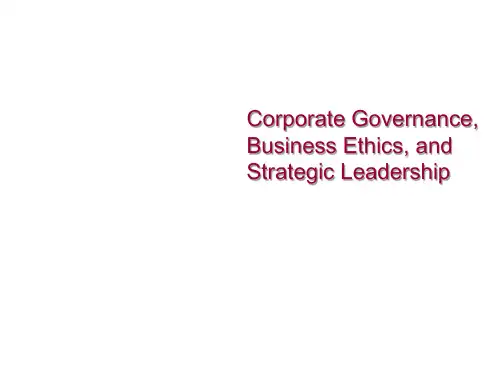
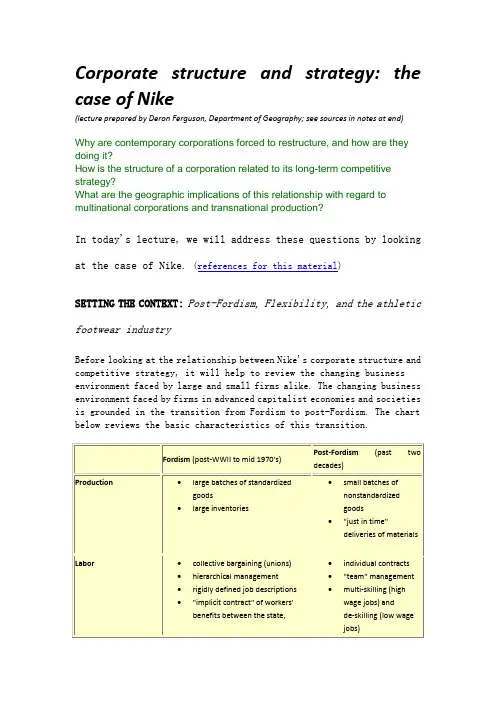
Corporate structure and strategy: the case of Nike(lecture prepared by Deron Ferguson, Department of Geography; see sources in notes at end) Why are contemporary corporations forced to restructure, and how are they doing it?How is the structure of a corporation related to its long-term competitive strategy?What are the geographic implications of this relationship with regard to multinational corporations and transnational production?In today's lecture, we will address these questions by looking at the case of Nike. (references for this material)SETTING THE CONTEXT:Post-Fordism, Flexibility, and the athletic footwear industryBefore looking at the relationship between Nike's corporate structure and competitive strategy, it will help to review the changing business environment faced by large and small firms alike. The changing business environment faced by firms in advanced capitalist economies and societies is grounded in the transition from Fordism to post-Fordism. The chart below reviews the basic characteristics of this transition.The general trend over the past two decades has been a movement from a "standardized" to a "flexible" economy (Stutz & deSouza, pp. 358-361). Many exceptions can be found to this conception of how economies are changing (e.g., the recent acquisition of McDonnell Douglas by Boeing), but elements of it can be found virtually everywhere, depending on the type of industry involved.In this example, we will look at the athletic footwear industry. In particular, we can focus on the athletic footwear market as an example of the formation of new, highly volatile, competitive markets. Changes in the footwear industry can be summarized as:∙footwear production has grown rapidly //Overhead Fig 2∙intense competition and market volatility are indicated by the explosion in the number of "styles" of athletic shoes, and competition among brands //Overhead Fig 1∙ a key to success in the industry is innovation and the rapid turn-around of design and production∙however, the production of shoes remains inherently a "Fordist," labor-intensive process ∙producers must have output and design flexibility∙producers must preserve proprietary information and technology, yet be organizationally flexibleNike has succeeded in competing in the footwear industry with the following strategy: remain flexible in a volatile market by using subcontracting relationships overseas in low labor-cost countries.NIKE'S STRUCTURE AND STRATEGY∙"Nike" began in 1964 as "Blue Ribbon Sports," a seller of Japanese-manufactured footwear∙In 1970, as the athletic footwear market grew, the Nike brand name was born∙In order to gain greater control over production and assembly, Nike opened a plant in New Hampshire in 1973 (which it closed in 1986). The bulk of its production, however,has always been overseas through subcontracting relationships of varying loyalty andintensity. //Overhead Fig 3Today, 100% of Nike's production is by subcontractors, or "production partners." Nike has three type of subcontracting relationships: //Overhead Fig 4∙Developed partners: These production partnerships were first in Japan, but are now in Taiwan and South Korea). These partners produce the "upper echelon" of shoes, orexpensive "statement" shoes, typically in smaller batches (10-25K pairs a day). They aremore likely to collaborate in innovations with Nike, many are vertically disintegratedthemselves, subcontracting "nonproprietary" shoe components and materials to otherlocal producers. Those partners which produce solely for Nike receive monthly ordersfrom Nike which don't vary more than 20% to preserve production stability.∙Volume partners: These are large factories producing large batches of standardized, lower-priced footwear (70-85K pairs a day). Production is routinized and serves multiple(often more than 10) companies, other than Nike (e.g., Reebok). These are "capacity"contractors--they absorb the market risk associated with cyclical demand. Thesefactories are typically more vertically integrated, owning their own leather tanneries andrubber factories. They are not where the most innovative or "state of the art" shoes areproduced, as these factories produce for multiple companies; for this reason,relationships between Nike and these companies are less loyal.∙Developing partners: These factories are located mostly in Thailand, Indonesia, and China. These locations offer Nike very low labor costs and a "hedge" against rising laborcosts in other factories or exchange rate risk. These factories are more loyal to Nike;often they are the product of a joint venture between Nike and its developed partners inTaiwan or South Korea. Often, the joint investment into these factories raises their ability to manufacture increasingly sophisticated products more rapidly than if they wereproducing unaided.Why does Nike pursue this organizational strategy?∙Shoe production is inherently labor intensive (although technology can vary). Thus, labor is an important input for footwear producers to consider, but the labor process remainslargely routine in the assembly of shoe components.∙Subcontracting relationships provide organizational flexibility, moving market risk to partners, even though production processes remain largely routine.∙Southeast Asia offers several locational advantages to Nike: i) it is a rapidly growing market; ii) low-wage, "semi-skilled" labor is plentiful; iii) governments encourageinvestment and transnational production by relaxing the enforcement of labor standards. Key points to walk away with..The business environment (that is, with respect to markets, regulation, competition, innovation) sets the context in which corporations must strategize to preserve their market share and market power. This strategy involves a careful choice of how best to flexibly structure the firm's organization and production, in which geography plays an important role. We have looked closely at this relationship--between corporate structure and strategy--by looking at Nike. By doing so, we have highlighted the fundamental relationship between geography, corporate structure and strategy, and transnational production.Concepts:corporate restructuringmultinational corporationstransnational productioncorporate strategycorporate structureflexibility (flexible production; flexible organization)Fordism, post-Fordismsubcontractingvertical disintegrationglobalizationNew International Division of Labormarket volatility企业结构与策略:耐克的情况下,(演讲准备德隆-弗格森,地理系;票据月底来源)为什么是当代公司被迫重组,以及他们是如何做的呢?相关法团结构,其长期的竞争策略是怎样的?这关系着跨国公司和跨国生产方面的地理意义是什么?在今天的讲座中,我们将看耐克的情况下解决这些问题(这种材料的引用)设置背景:后福特主义,灵活性,以及运动鞋产业在耐克的企业结构和竞争战略之间的关系,这将有助于审查大型和小型企业都面临的不断变化的业务环境。
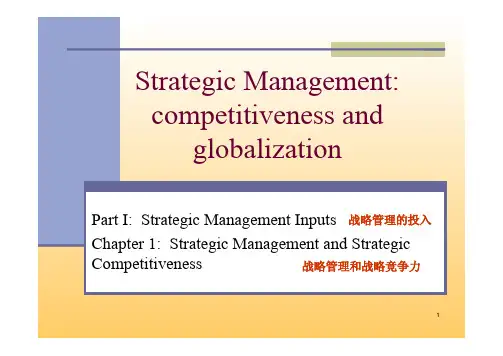
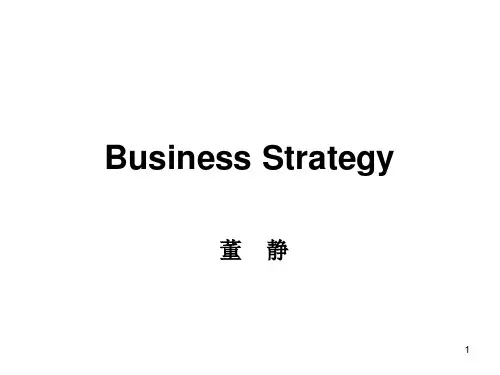
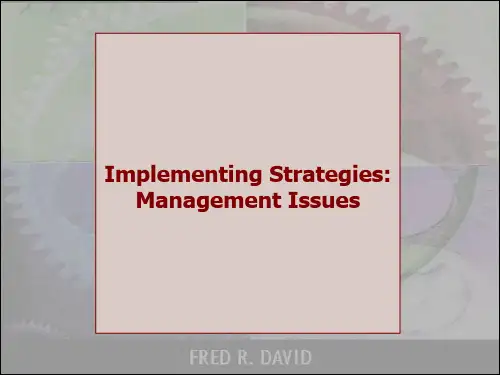
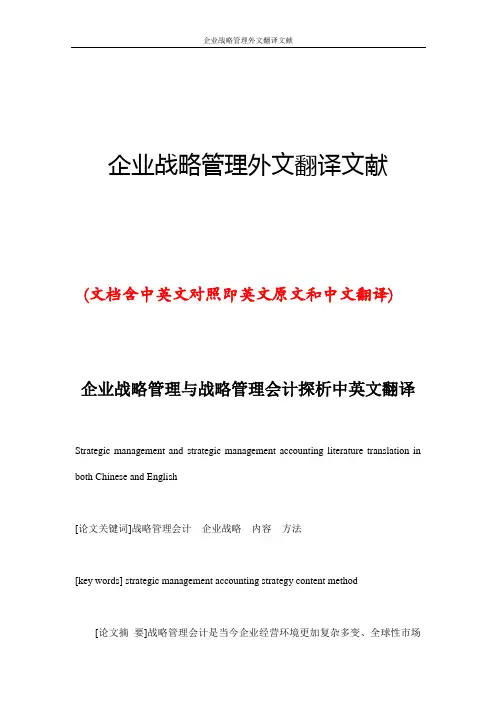
企业战略管理外文翻译文献(文档含中英文对照即英文原文和中文翻译)企业战略管理与战略管理会计探析中英文翻译Strategic management and strategic management accounting literature translation in both Chinese and English[论文关键词]战略管理会计企业战略内容方法[key words] strategic management accounting strategy content method [论文摘要]战略管理会计是当今企业经营环境更加复杂多变、全球性市场竞争空前广泛激烈的情况下,为满足现代企业实施战略管理的特定信息需要而建立的新的管理会计信息系统。
本文从战略管理会计的内涵、目标及特点阐述到战略管理会计的主要内容和方法对战略管理会计进行论述。
/ paper pick to strategic management accounting is the enterprise management environment is more complex, an unprecedented high competitive global market, to meet the modern enterprise to implement strategic management specific information need and establish a new management accounting information system. This article from connotation, goals and characteristics of strategic management accounting to the main content of strategic management accounting and methods of strategic management accounting in this paper.一、从企业战略的高度来看战略管理会计One, from the perspective of the height of business strategy, strategic management accounting1981年,英国学者西蒙斯最早将管理会计与战略管理相结合,提出战略管理会计之说。

战略管理双语资料(共71页)--本页仅作为文档封面,使用时请直接删除即可----内页可以根据需求调整合适字体及大小--Chapter 1 Strateg ic Ma n a gem e nt a nd Str a tegic Com pe titiven e ss ................... 错误!未定义书签。
Management Process .............................................................................. 错误!未定义书签。
The Rational Model ....................................................................... 错误!未定义书签。
The critique of the rational model .................................................. 错误!未定义书签。
The New Competitive Landscape ........................................................... 错误!未定义书签。
Globalized Competition ................................................................. 错误!未定义书签。
Changes .......................................................................................... 错误!未定义书签。
I/O model of Above-average Returns ..................................................... 错误!未定义书签。
《企业战略管理》课程笔记第一章:战略管理导论一、战略管理的产生与发展1. 战略管理的起源- 古代军事战略:战略一词最初源于军事领域,指的是军事指挥官在战争中为实现胜利目标而进行的计划和行动。
- 企业管理应用:20世纪初期,随着工业革命和企业规模的扩大,战略管理的概念开始被引入到企业管理中。
2. 战略管理的发展阶段- 古典战略管理阶段(20世纪初-20世纪50年代)- 关注点:主要集中在企业内部管理,如生产效率、成本控制等。
- 代表人物:弗雷德里克·泰勒(Frederick Taylor)的科学管理理论,亨利·福特(Henry Ford)的大规模生产模式。
- 现代战略管理阶段(20世纪60年代-20世纪80年代)- 关注点:企业外部环境分析,竞争战略的制定。
- 代表人物:彼得·德鲁克(Peter Drucker)提出企业目标理论,迈克尔·波特(Michael Porter)的五力模型和竞争战略理论。
- 战略管理整合阶段(20世纪90年代至今)- 关注点:战略管理的系统性和整体性,强调内部资源和能力与外部环境的匹配。
- 代表理论:资源基础理论(Resource-Based View, RBV),核心能力理论(Core Competence)。
二、战略的内涵1. 战略的定义- 战略是一系列决策和行动,旨在通过配置资源和调整活动,实现企业的长期目标和愿景。
2. 战略的特点- 全局性:战略涉及企业的整体方向和所有业务领域,要求从全局角度考虑问题。
- 长期性:战略规划通常跨越数年,甚至数十年的时间,关注企业的长远发展。
- 导向性:战略为企业管理层和员工提供明确的方向,引导企业资源向既定目标集中。
- 动态性:战略需要根据外部环境的变化和企业内部条件的发展进行适时调整。
三、战略管理的内涵与构成要素1. 战略管理的内涵- 战略管理是一个系统性的过程,包括战略的分析、制定、实施和评价,旨在提高企业的竞争力和适应环境变化。